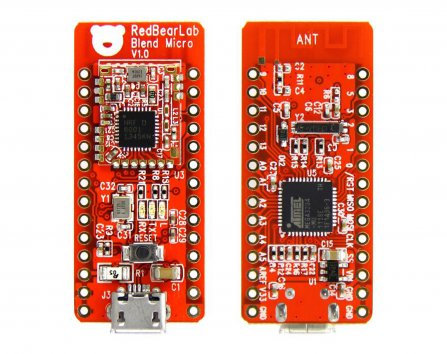RedBearLab’s Blend Micro is an Arduino compatible board with Bluetooth 4.0 Low Enery (aka Bluetooth Smart) connectivity, that’s part of Arduino-at-heart, a partner program initiated by the developers of Arduino boards. It has been made to help design low power Internet-Of-Things (IoT) projects quickly and easily.
 Blend Micro technical specifications:
Blend Micro technical specifications:
- MCU – Atmel ATmega32u4 @ 8 MHz with 32KB flash (4KB used by bootloader), 2.5 KB SRAM, and 1KB EEPROM.
- Connectivity – Bluetooth 4.0 Low Energy via Nordic nRF8001 chip
- USB – 1x micro USB port
- I/Os:
- Serial (Tx/Rx)
- I2C, SPI
- PWM
- U to 16 Digital I/Os
- Up to 6 Analog inputs
- Operating Voltage – 3.3V
- Input Voltage – 5V (USB), and 3.3-12V (VIN)
- Power Consumption – 2mA (average – using Interrupt mode)
- Dimensions – 43.6 x 18.4 x 4.3mm
- Weight – 4g
The specs are very similar to BLEDuino, except it’s slightly smaller. Blend Micro can communicate with BLE enabled devices running one of the following operating systems:
- iOS 7 – iPhone 4s, iPhone 5, iPod Touch 5, iPad 3/4/mini/Air
- Android 4.3 or above, but Android 4.4 is recommended for stability. E.g. Nexus 4, Nexus 7.
- Windows 8.1 with built-in Bluetooth 4.0 or USB dongle
- Linux with BlueZ 5.1 with built-in Bluetooth 4.0 or USB dongle
I understand these are supported via Nordic Bluetooth Smart SDK for Arduino, and development can be done via the standard Arduino IDE, and soon it will even be possible to download your sketch over the air. RedBearLab has also released “BLE controller” demo app for Android and iOS.
You can find more information, including a getting started guide, on RedBearLab’s Blend Micro page, and order the device via Arduino Store for 25.40 Euros + VAT and shipping.

Jean-Luc started CNX Software in 2010 as a part-time endeavor, before quitting his job as a software engineering manager, and starting to write daily news, and reviews full time later in 2011.
Support CNX Software! Donate via cryptocurrencies, become a Patron on Patreon, or purchase goods on Amazon or Aliexpress





The nRF8001 chip used in this is rubbish. Since its BLE stack runs entirely on the Arduino side it uses a lot of resources from the Atmega chip (RAM and pins) and it’s very unreliable too, the stack crashes a lot.
I recommend you go a RFduino instead which has a nRF51822 (ARM M0 core, lots of RAM). It’s cheap and very easy to use. Also when/if you grow out of the Arduino environment you can program it in C using the open MBED platform.
It’s painful to see the Arduino guys peddling this junky one instead. They don’t “get” BLE at all.